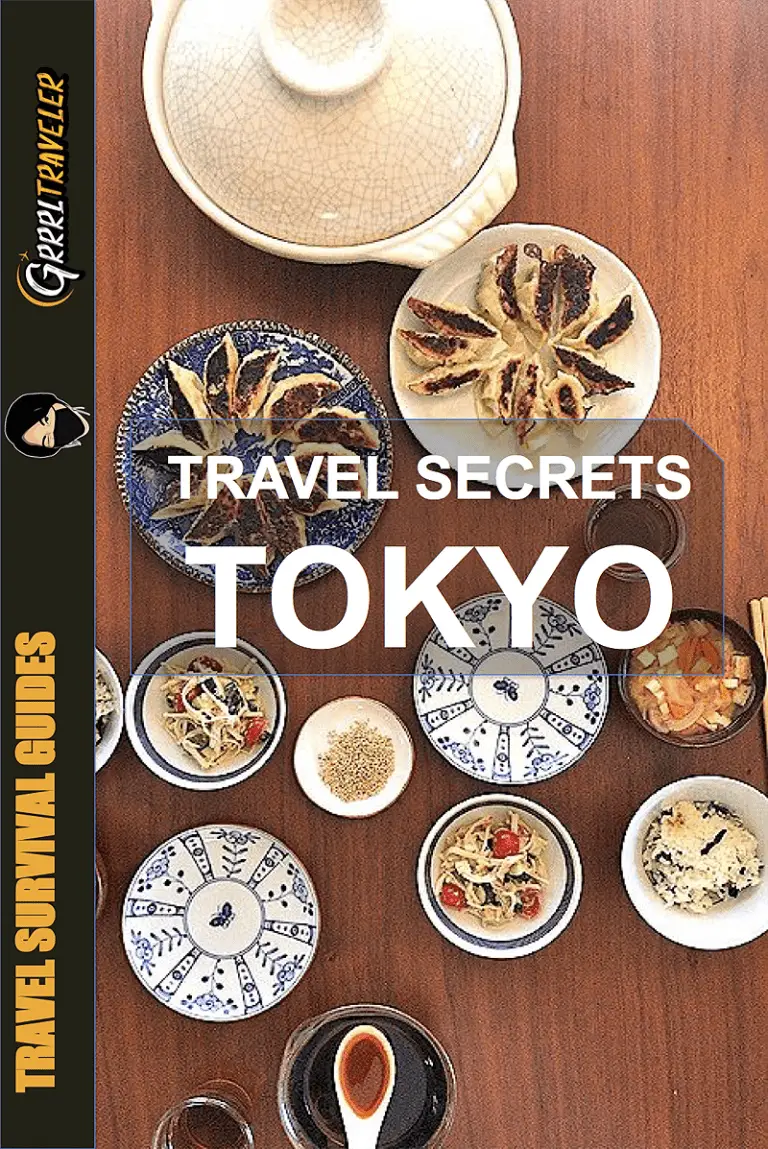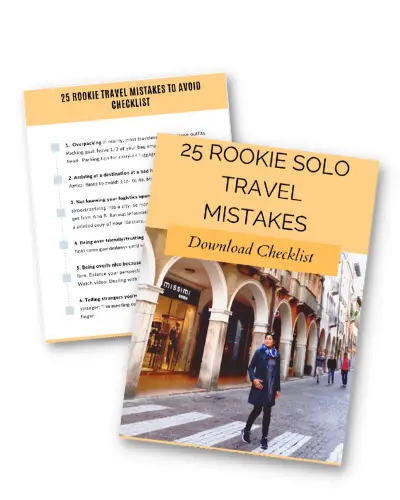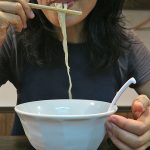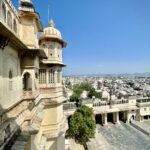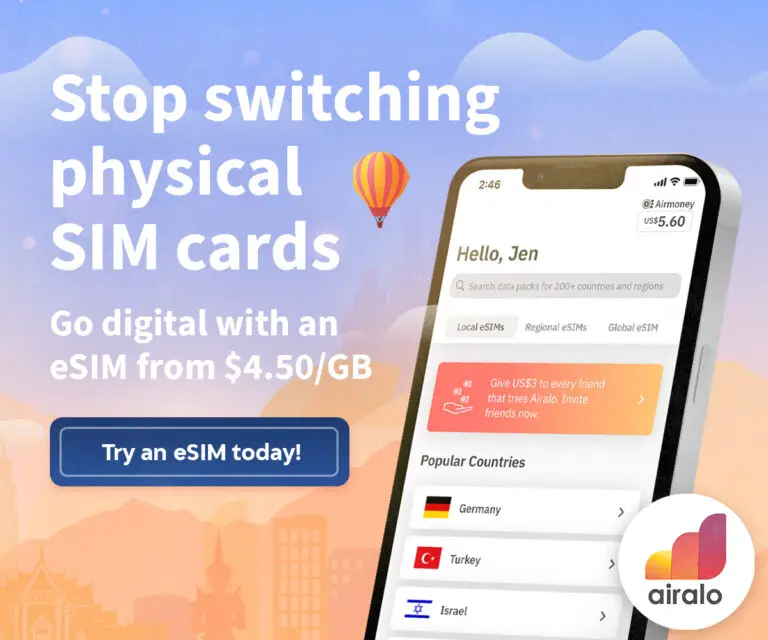Last Updated on June 13, 2024 by Christine Kaaloa
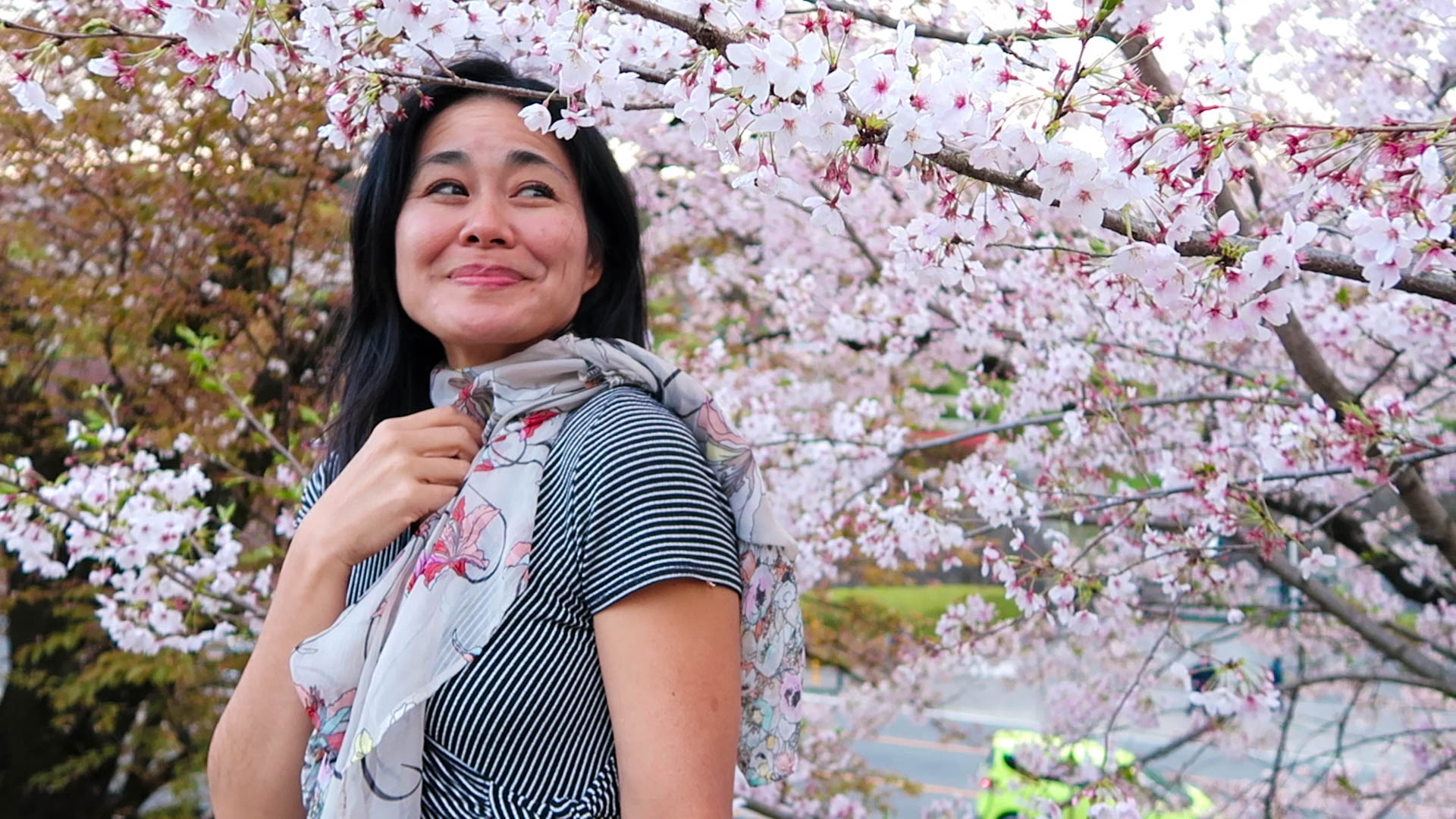
Kyoto was the capital of Japan for more than 1,000 years, so there are many historical sites to visit such as temples and shrines. The city has a rich cultural heritage with its traditional arts, crafts and cuisine. Kyoto is also famous for its beautiful natural scenery, including cherry blossoms and seasonal foliage.
I’m sharing a Kyoto travel guide countdown of the best things to do in Kyoto. If at the end, this is not enough for you to make the leap to traveling Japan alone, you’re welcome to join me on my Sustainable Japan group tour!
Read my Japan Budget Tips
Japan is cracking down on tourism in Kyoto
Table of Contents: 16 Romantic Things to Enjoy in Kyoto Alone
- 1 16 Romantic Things to Do in Kyoto Alone
- 1.0.1 Gion
- 1.0.2 2. Maruyama Park
- 1.0.3 3. Arashiyama Bamboo Forest
- 1.0.4 4. Keage Incline
- 1.0.5 5. Kiyomizu-dera Temple
- 1.0.6 5. Ryoanji Temple
- 1.0.7 6. Heian Shrine
- 1.0.8 7. Kiyamachi Dori
- 1.0.9 8. Sagano Romantic Train Ride
- 1.0.10 9. The Philosopher’s Walk
- 1.0.11 10. Nishiki Market
- 1.0.12 11. Kyoto food tour
- 1.0.13 12. Fushimi Inari Shrine
- 1.0.14 13. Kinkakuji Temple
- 1.0.15 14. Kyoto Imperial Palace
- 1.0.16 15. Samurai & Ninja Museum
- 1.0.17 16. Travel with me to Japan!
- 2 Where to Stay in Kyoto
- 3 Best ways to get around Kyoto
- 4 Getting Around Kyoto & Japan
The Japanese are a polite culture with unique societal rules. But lately it’s been cracking down on travelers that act rude, disrespectful and whom interfere with the daily working life of local Japanese.
Due to the popularity of Kyoto’s geisha district of Gion, tourists over the years have attempted to stalk, harass, take photos of and interfere with geisha and maiko on their way to work. When I last visited in 2019, there were signs informing tourists of things that were prohibited in this neighborhood and disrespecting or interfering in the work of the geisha was a large one. Later Kyoto prohibited taking photos and selfies with geisha, as tourists were still stalking the geisha in the hope of a momento from their sighting. Today, the city of Kyoto has prohibited tourists from straying from side streets of Gion. Instead, tourists must stay on the main streets. Read more about the new rules for travelers.
Check out my Responsible travel tips for Ethical Travelers
16 Romantic Things to Do in Kyoto Alone
-
Gion
Gion is one of the most popular tourist destinations in Kyoto. It is also one of the most historical and famous geisha districts in Japan. From old-style buildings and tea houses to restaurants, stroll the neighborhood and you’ll feel like youre stepping back in time. When i filmed this video, rules were still a little loose and I was led by a local guide, so I followed cultural etiquette. Watch my video below for insight and the top attractions of Gion.
Tip: If you see a geisha, typically they are busy getting to work so do not disturb them for a picture.
Read the rules before entering Gion’s geisha area. Side streets are off limits and no photography of the geishas are allowed. Read the new rules outlined by Japan
2. Maruyama Park
Located in Higashiyama district next to Yasaka Shrine of Gion, sits Maruyama Park, a popular social spot for hanami. There are over 680 cherry trees of different varieties and a restaurant area where you can gather with friends to enjoy a meal. The most popular gathering spot is the iconic weeping cherry tree which is lit up at night. At night the park has illuminations (or tree lightings) so you can continue their merriment under the sakura stars. Festival seasons, like cherry blossom season, is the best time to visit. The park has food vendors selling all types of fun street food dishes.
As Yasaka shrine is neighboring, it’s ideal to explore the shrine grounds, where there is a shrine dedicated to fertility and to beauty. The latter is said to be one that many maiko and geisha like to visit.
Getting there: 10-minute walk from Gion Station (towards the direction of the Minamiza Kabuki Theatre; not the bridge).
Read Things to know before visiting Japan

3. Arashiyama Bamboo Forest
By far, one of my favorite and most peaceful spots in Kyoto is Arashiyama Bamboo Forest. As one of Kyoto’s highlights, Arashiyama neighborhood is a lush oasis, set against the beauty of nature, hills, and the lovely Katsura River. There’s a handful of things to do at the bamboo forest and I can easily spend over half a day here, at the very least. You can hike Arashiyama Bamboo Forest during the day or visit it at night when it’s lit up. Take a selfie on Togetsukyo (aka ‘Moon Crossing’ Bridge) or picnic along the Katsura River. There is also a monkey forest (which I keep missing) and you can take in Tenryuji temple’s beautiful and peaceful garden. Arashiyama neighborhood is a lovely spot full of restaurants, sweet shops and shopping.
Tip: Right outside the bamboo forest there are street food shacks with vendors selling foods like bamboo udon (a must if you’ve just hiked the forest), soft yodofu tofu (Kyoto is famous for this) and my favorite dango snack, mitarashi dango (a dango stick dipped in sweet soy sauce).
Watch my video, check out my Kyoto must try foods list and Kyoto’s 6 best places to eat for foodie tips in Arashiyama!
Getting to Arashiyama: These metro station stops arrive in or near it- JR Saga-
4. Keage Incline
Keage Incline is an abandoned railway, which used to transport ships between the Lake Biwa Canal to the Okazaki Canal. During cherry blossom season, the cherry trees create a kind of a tunnel over the tracks. The tracks make for a popular Instagram spot, so arrive early if you don’t want anyone in your shot. I did not get there early. By the time I arrived, it was afternoon and the crowd was there. But it did not take anything away from the atmosphere and I still got my selfies in!
To be candid, the railway is only good for a photo opportunity. There is not anything else to see there.
Read tips on how to vlog your selfies
Getting to Keage Incline: 4 min walk from Keage Station , Higashiyama,
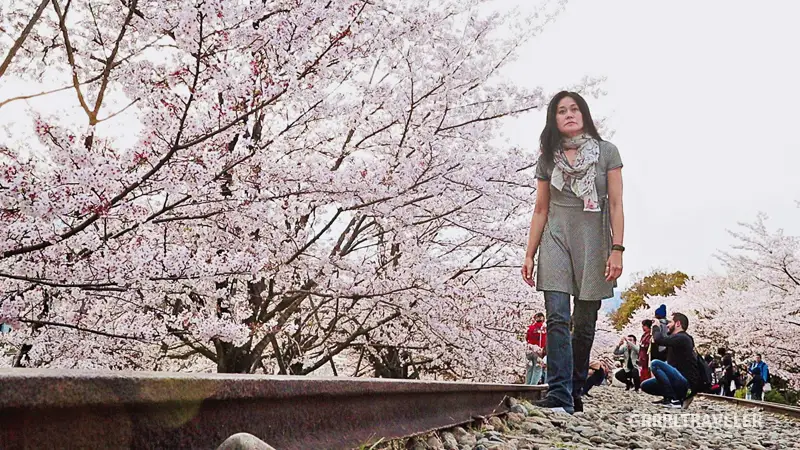
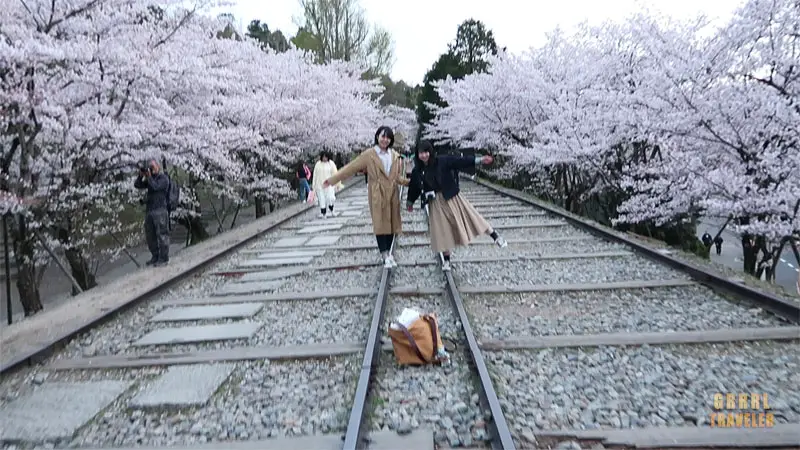
Travel with me to Japan: Join my Japan group adventure
5. Kiyomizu-dera Temple
Kyoto’s Kiyomizu-dera Temple (aka Temple of Pure Water Spring) is known for its medicinal and wish-granting waters of Otowa Spring and its 3-story Koyasu Pagoda.
During cherry blossom season, it also houses 1500 cherry blossom trees on its hilly slopes. I didn’t see that many blossoming trees when I arrived but it is possible the area was not blooming at that time. The iconic temple shot is said to be a panoramic shot from behind the temple looking out. Unfortunately, the temple was under construction when I was there. But as a temple grounds, you can explore the area, enjoy the three-story pagoda, and wishing waters.
Tip: I recommend exploring the neighborhood and streets leading up to Kiyomizu-Dera. They have an old Kyoto architectural vibe with a lot of souvenir, boutique, tea and snack shops. You won’t regret spending a little time wandering this area.
Check out 10 Best Cherry Blossom spots in Kansai
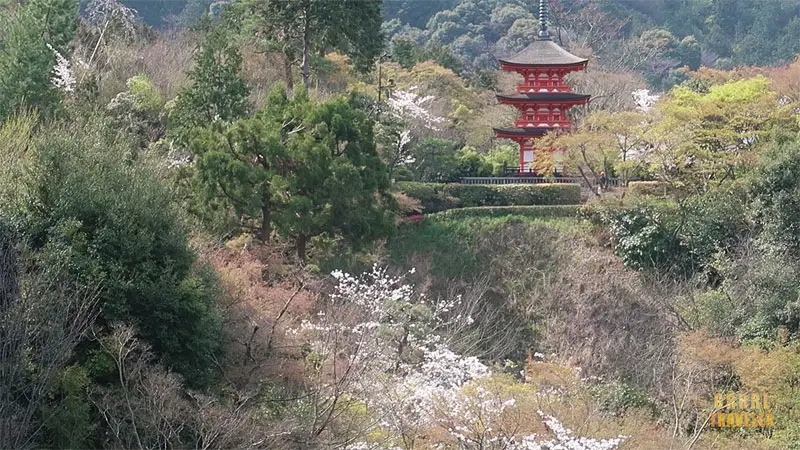
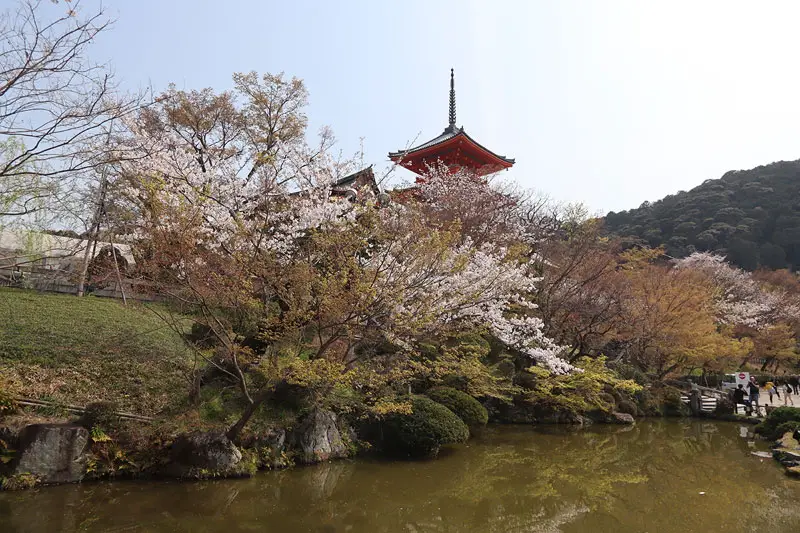
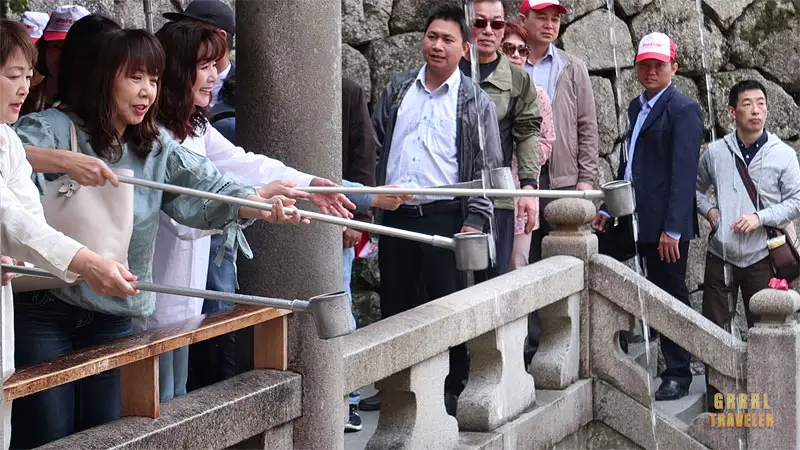
5. Ryoanji Temple
A stone’s throw from the Golden temple is Ryoanji Temple (or Peaceful Dragon temple), a Zen Buddhist temple that was once a Zen center during the 16th and 17th centuries. The architectural and Zen garden aesthetics invite meditative reflection and peace. It is famous for its Zen rock garden. Travelers love to spend time sitting at the rock garden, meditating, journaling or just soaking in the tranquility and calm that you feel when you visit.
6. Heian Shrine
Getting to Heian Shrine: Take bus 5 or 100 to Heian Shrine. It is right before the giant red torii gate that stands as a welcome towards the shrine grounds. I didn’t spend much time on looking around as to get to the garden (where the cherry blossoms were) you need to pay an admission fee. By that time, I was starting to feel like when you’ve seen one shrine, you’ve seen them all..

7. Kiyamachi Dori
You can always find wonderful impromptu spots around the city. One of my favorite but lesser-known spots and one that tourists don’t know about is Kiyamachi Dori or Kiyamachi Street. In the heart of Kyoto, near Gion, parallel to Pontocho Alley and the Kamo River, Kiyamachi Street is a popular local nightlife and restaurant walking street with a river canal running through it. If you get lost, just follow the barbeque scent which permeates the area. Strolling at night with the lights of its surroundings, its buzz and local crowds make it feel almost romantically electric. Nearest Stations: Gion Station / Higashiyama Station
8. Sagano Romantic Train Ride
Beautiful at all seasons is the Sagano Romantic Train Ride. This is a sightseeing train that runs through the picturesque Arashiyama-Sagano area to Kameoka Torokko station and overlooks a river gorge dotted by cherry blossom trees. It’s a fairly short ride (approximately 15 -20 minutes). Once at Kameoka Torokko station you can either take a lovely boat ride back down the river gorge or take a return train. When I went, the boat ride was closed due to the weather so I took the train back. The return train ride makes a couple of stops and it can be confusing. I got off prematurely and ended up hiking back to the train station on a drizzly day, so make sure you pay attention to the stops or ask the station guard at Kameoka Torokko station. This is especially beautiful to take during cherry blossom season (directions here). You can buy your tickets directly from the Kameoka Torokko station, but during cherry blossom season you may want to book them in advance as this ride is quite popular.
Tip: Seats on the train are first come-first serve. Nab a seat on the right side of the train (from the front of the train) as much of the gorge is seen. Book a Sagano Train ride day tour and lighten your stress in finding your way around
Read How to plan your cherry blossom trip to Japan
9. The Philosopher’s Walk
Noted as one of the Top 100 Paths of Japan, The Philosopher’s Walk is a path running along a canal stretching two kilometers with 500 Yoshino cherry trees lining the way. The path was named after a famous philosopher who used this walk as his meditation. The path runs from Ginkakuji temple (not to be confused with Kinka-kuji temple aka Golden Temple) to Nanazenji Temple. The walk is a lovely with the cherry blossoms in bloom as it winds through neighborhoods in the area, but it can be a fairly substantial hike. There’s no hills so it’s a flat walk, but there are no train stations in between if you get tired. You’ll either need to complete the walk or hail a taxi to take you to the station.
Read Best Cherry Blossom spots of Kansai
Tip: I used my Google Maps app to find the train stop. I recommend purchasing a Japan SIM card to make your navigating Kyoto easier.
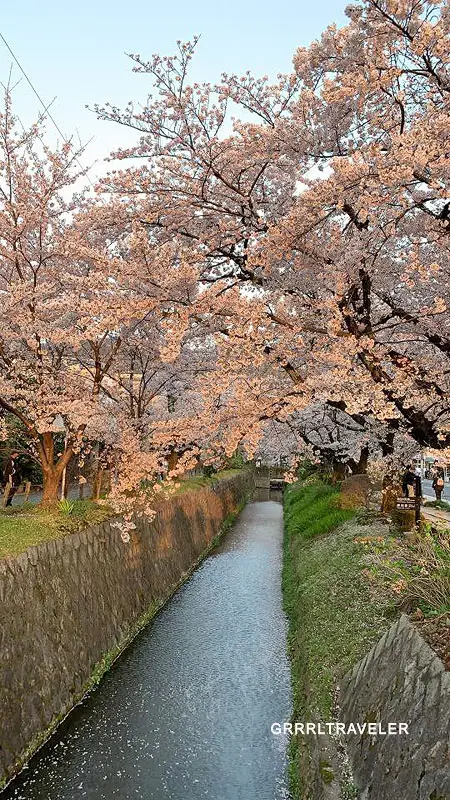
10. Nishiki Market
With over 130 food shops and restaurants, the food variety at Nishiki Market is refreshing and surprising. Housed under a covered arcade (aka shotengai ), it is a five-block-long walking street and locals still shop there for their households. Each food stall offers something unique to Kyoto tradition. The dishes were reasonably priced and you could notice high-quality ingredients and their freshness with a nibble. I took a food tour and found there is so much to learn about the market foods here and it was nice to be able to sample it without having to buy entire dishes.
I highly recommend taking a Nishiki Market Street Food tour to sample Nishiki Market foods, learn about the geisha & maiko culture, and more.
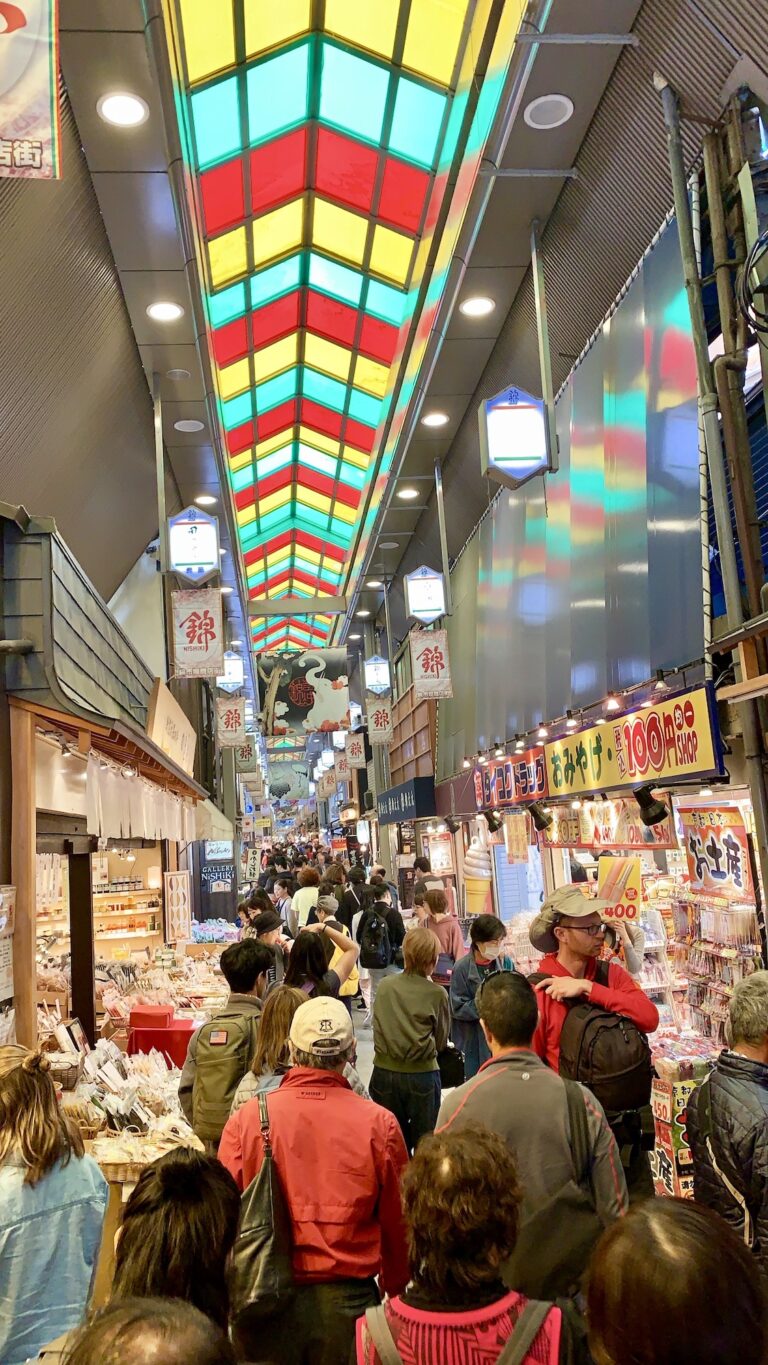
11. Kyoto food tour
Kyoto is known for its traditional food culture and a lot of its cuisine is based on the ingredients that are in season, so I recommend taking a Kyoto food tour to maximize your Kyoto food experience and gain insight to the Kyoto dinner table. I took a food tour of Nishiki Market (read my review) and I learned so much about the foods Kyoto is known for. Some must-try foods to eat while in Kyoto include:
–Yakitori: Yakitori is a Japanese dish where skewered chicken, vegetables, or seafood are grilled over charcoal.
–Tsukemono: Tsukemono are pickled vegetables that are usually eaten with rice or as a side dish.
–Nimono: Nimono is a type of dish where ingredients like fish, chicken, or tofu are simmered in soup stock and served with rice.
– Tofu: Kyoto is known for it’s excellent water quality and as a result, tofu is farmed here. Another unique type of tofu or tofu skins is yuba and you can find this ingredient in anything from soft serve ice cream to donuts.
Kyoto Food Tours
- Gion Food tour Explore standing bars, tapas, and Gion entertainment
- Kyoto Gion Tour Kaiseki meal, learn about Geisha & Maiko culture, and more
Check out my Kyoto food guide for more must-try foods of Kyoto!
12. Fushimi Inari Shrine
Fushimi Inari Shrine is a beautiful shrine that is located in the mountains of Kyoto, Japan. It is one of the most popular shrines in all of Japan and it attracts more than 3 million visitors per year. The shrine is composed of thousands of red torii gates that line a long and winding path up to the main gate. The site itself has been designated as a UNESCO World Heritage Site
Tip: I recommend spending some time there. The walking path turns into a bit of a mild hike where you will come across altars of red torii and fox shrines. Highly worthwhile to explore where the path takes you.
13. Kinkakuji Temple
The Kinkakuji Temple or Golden Pavilion is a Zen Temple that was once the retirement villa for the shogun Ashikaga Yoshimitsu. It’s a must and one of my favorite landmarks in Kyoto. It’s top two floors are covered in gold leaf. The temple is surrounded by a lake with manicured Zen trees. Admission fee: 300 yen for children; 400 yen for adults
Tip: While you’re in the neighborhood, take in a Japanese tea ceremony where you dress in a kimono and learn about matcha green tea and the ceremonial practices around it. I’ve not done the kimono part, but the ceremony is quite a beautiful and peaceful experience!
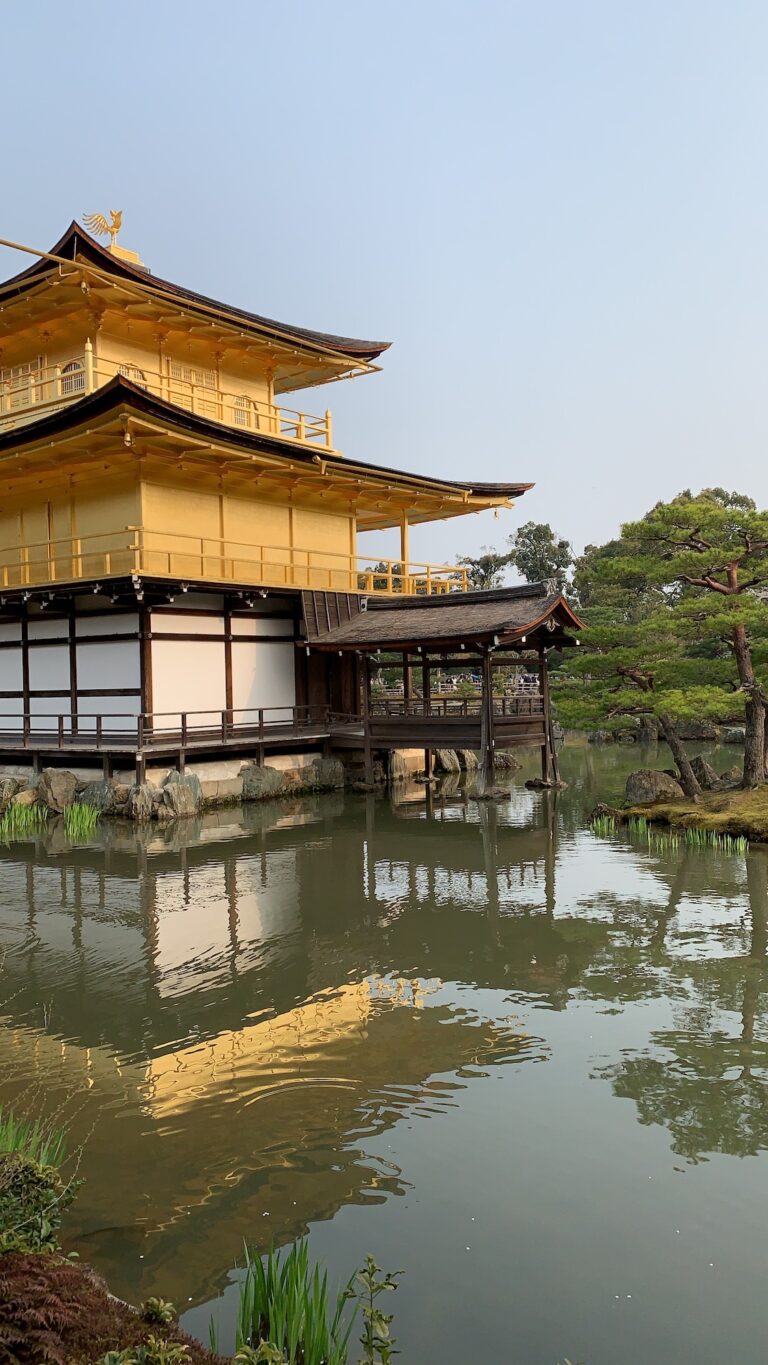
14. Kyoto Imperial Palace
Kyoto Imperial Palace is a beautiful palace complex located in the heart of the city. It is one of the most famous tourist attractions in Kyoto. It has been used as a home for the Imperial Family and their household since 1868, when Emperor Komei (ninth emperor of Japan) relocated to Tokyo.
15. Samurai & Ninja Museum
The Samurai and Ninja Museum is a must for anyone interested in Japanese history or who’s ever had a dream to be a ninja. There are Edo period samurai and katana exhibits. Visit a samurai village and house with a dojo for ninja and samurai instruction. Book advance tickets here. Located: 292 Higashi Daimonjicho
16. Travel with me to Japan!
Have you watched all my YouTube solo travel videos and it’s still not enough to compel you to travel to Japan alone? Join me and many like-minded travelers who want to eat and explore their way through Japan with a unique itinerary which blends sightseeing with authentic local experiences and of course, tons of food. Join me on one of my adventures and travel with me to Japan and join my Iconic Japan group tour.
Where to Stay in Kyoto
Continuing on with the best things to do in Kyoto, I wanted to continue my Kyoto top attractions with the best hotels to stay.
Check out my Kyoto capsule hotel recommendations
The Glansit Kawaramachi Capsule Hotel was a favorite stay of mine. Located one or two streets from Pontocho Alley and 4 minutes from Gion Station, it was smack in the heart of downtown Kyoto and a five-minute walk to Gion, crossing Shijo Bridge. The capsule hotel is lovely with a classy-looking check-in lobby that feels like a “hotel”. Locker and dressing areas are a little snug, capsule rooms are standard and comfy and there is a reading room with free coffee and tea. Upgradable capsule rooms with study desk space and upstairs bunk bed. Reasonable rates for Kyoto too. Sexes are separate. I’d happily stay there again.

If you love Japanese manga (comic books), Comicap Capsule Hotel is your soulmate. It is a coed capsule hotel with a manga cafe theme, it houses a library of manga, a comfy and cute lounge area for eating and for kicking back and luxuriating on your own reading bed. It has a mini kitchen if you want to microwave anything and offers free coffee and tea. A little difficult to find at first, it is housed on the second level in a shotengai (the elevator/entrance is hard to find as it is tucked inside a mini alley. English is available in written directions and instructions but was not spoken when I stayed there (the front desk pointed at instructions). Located 8 minutes from Gion station and not too far from a bus stop.
Best ways to get around Kyoto
Kyoto is a large city, so you won’t cover it in a day. It’s best to spend at least two or three days here. I took a day tour to knock off many of Kyoto highlights, so I could spend the rest of my days exploring niche neighborhoods. But it’s always nice to have a personal guide for the day so you get the most of the activities you’re interested in. If you have a family, I recommend a personalized family day tour so you can visit more family-friendly spots for kiddos.
Due to the fact the metro and train system is smaller than Osaka and Tokyo and buses are used more readily. You can also hire a taxi.
Kyoto public transportation
Navigating Kyoto via public transportation is not difficulty however, it is not as easy as other Japanese cities which rely on the metro. With Kyoto its fair to expect you’ll be using a combination of train and bus. So I highly recommend getting a ICOCA card, PASMO or SUICA card. These are all smart and reloadable transportation cards which let you use Japan’s public transportation. I always get either the PASMO or SUICA. There’s not much of a difference other than they are owned by different private companies.
It is relatively easy to use the bus as a foreigner as there are English translations and many bus drivers can have a slight understanding of the language.
Traveling to Osaka and Nara from Kyoto
The travel distances between these cities are close, with Osaka being 45 minutes from Nara and an hour to Kyoto. So I planned my crossover into each city in a sort of circular progression- Osaka, Nara, Kyoto, Osaka. I knew that -at thevery most- I might have seven days to experience hanami and sakura in the cities. But given a storm or strong winds and rain, I assumed those flowers could fall within a day, as well.
Osaka is the best strategic home base for visiting nearby cities it seems. Intercity it is well connected with trains, metro and bus and it has two airports which can both be reached by metro, bus or train. While Osaka is not as lovely as Kyoto and its mountains and rivers, Osaka has a fun character, great food and you’ll easily find a lot to do and shop in Osaka. Tip: Get an Osaka Amazing Pass (unlimited rides and free attractions- I got a two day pass)
Nara is a MUST. It is a day trip and a much smaller city to navigate. From Nara station, you can get to the main attractions and Nara Park on foot. See my Nara Travel guide
Getting Around Kyoto & Japan
Japan Railway | Japan Rail Pass (JR Pass)
Many travelers opt to skirt around Japan by way of the Japan Railway. The Japan Rail Pass is the perfect option if your itinerary is crunched with cities and very little time. JR Pass Options are sold in 7 day, 14 day and 21 day categories, and it includes all JR trains (Shinkasen, Express, Local, etc..), the monorail to/from Haneda airport, highway buses and more! Rates start at 28,000 yen and you must pre-purchase your passes in advance.
Most popular : 5 day flexible East Tohoku JR Pass
(surrounding Tokyo area to countryside; Shinkasen, Narita Express, Tokyo Monorail included)
Note: you can only buy these passes outside of Japan. Plan ahead. The pass offers tourists a big discount on travel; however, if you only have a few cities to visit, it may be more cost-efficient to book point-to-point travel.
Planning a trip to Tokyo? Get my Tokyo Travel Secrets eguide
Watch my video: Top 10 cherry blossom spots of Kyoto, Osaka, Nara
What would you add to Kyoto travel guide? Comment below.
Recommended Trip Planning Services:
Travel with me and join me on my next group adventure!
Getyourguide is my favorite tour booking site. Find everything from food tours, city sightseeing discounts, SIM cards and more
Discover Cars finds the best car rental price quote.
Booking Yoga Retreats – a huge directory of yoga, surfing, meditation retreats around the globe.
Skyroam– Global wifi (take 10% off with my referral code GRRRLTRAVLER)
Booking.com who I book accommodations with
World Nomads trip insurance that covers my adventure style in travel.
Download your free customizable trip packing checklist


